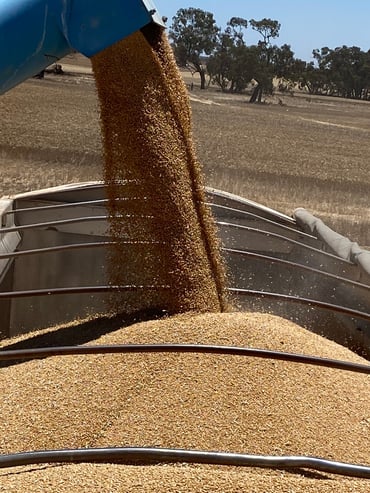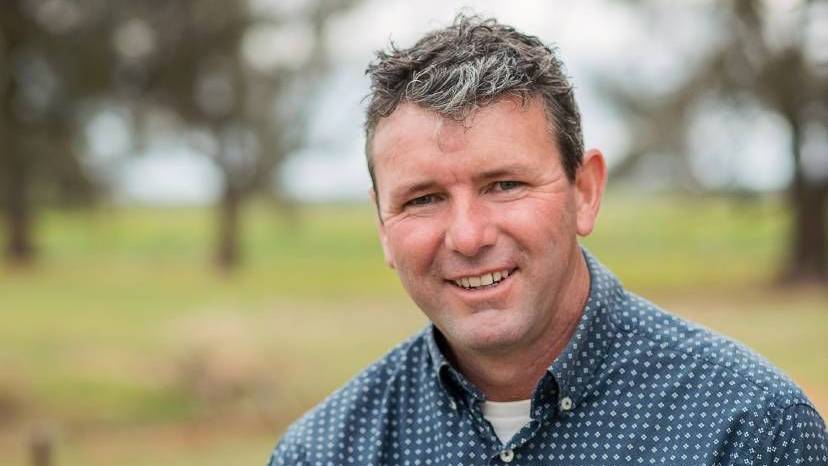
Brett Hosking was recently chair of GrainGrowers Australia and is a former vice president of the Victorian Farmers Federation. A fifth-generation farmer, he runs a mixed farming operation in the Mallee with his wife Jane and his four daughters.
When I first started farming, a local farmer told me that if you can successfully farm for ten years then you can successfully farm forever. What he meant was that in a ten-year period, you will see the best of seasons and the worst of seasons. This felt true at the time, but a changing climate is now challenging that assumption.
In the past five years, on the east coast of Australia, we have seen possibly the driest farming conditions followed closely by some of the wettest. A changing climate is challenging us as growers by creating an environment for more extreme weather events from the driest droughts to the wettest floods. Our potential for late season frost has increased and so has the chance of summer storms damaging our ripe crops.
This month, I joined the board of Farmers for Climate Action, which now represents 8000 farmers from all farming systems across Australia. I did this to help make sure our farmers are empowered and supported to adapt their practices to manage a changing climate, and to play an active role in helping to reduce emissions, to mitigate against further change.
I’ve spent years working alongside farmers in the Victorian Farmers Federation and at GrainGrowers, and I am continually inspired by their ability to find real solutions to real life challenges. I’m convinced that the more information we can give to farmers, the greater their ability to find tangible solutions to the challenges of a changing climate.
Farmers for Climate Action commissioned Ernst and Young to do a report on the opportunities in a low carbon economy a couple of years back. It found farmers could increase productivity and maintain herd and flock size as we lower emissions. I also believe that as farmers reduce their emissions, other sectors have to pull their weight too. We take the brunt and the risk of a changing climate, and we can’t reduce Australia’s emissions all on our own.
 Above: Brett Hosking with wife Jane and their four daughters. Photo supplied.
Above: Brett Hosking with wife Jane and their four daughters. Photo supplied.
My wife Jane and I farm alongside our four daughters, Grace, Lily, Isabelle and Amelia at Quambatook in Victoria’s Mallee. Ours is mostly a cropping business growing canola, barley, wheat, oats, and lentils. We also produce some vetch hay depending on the season. To complement the cropping, we also run a self-replacing flock of Merino ewes using Tamaleuca bloodlines from Kevin Crook at Ouyen. From time to time, we have some beef cattle and currently are running some Hereford breeders. All of the girls take an active interest in the farm, providing valuable help during busy seasons such as shearing, harvest and seeding. Lily has taken a step further, buying a few steers of her own.
I want my family to continue farming into the future, preferably with reliable rainfall. One of the strongest attributes Australian farmers have is our ability to produce food and fibre in a way that reflects the values of many of our trading partners – food that is sustainably produced to some of the highest food safety and grading standards.
 The same cost of living pressures that many Australians are feeling are being felt on our farm. We’ve seen price rises for fertiliser, crop protection products and fuel, as well as huge workforce challenges. Rising costs mean greater risk for farmers and so we are managing those risks, through crop and livestock diversification and rotation, more sophisticated grain marketing practices and more.
The same cost of living pressures that many Australians are feeling are being felt on our farm. We’ve seen price rises for fertiliser, crop protection products and fuel, as well as huge workforce challenges. Rising costs mean greater risk for farmers and so we are managing those risks, through crop and livestock diversification and rotation, more sophisticated grain marketing practices and more.
Farmers are used to managing risk. The resilience shown by our industry in the last few years has proven that. But we are not looking at the same type of risks that previous generations faced. We will have to plan for more extreme weather events, probably more global shocks and very likely regulatory changes. These financial risks and higher costs of a changing climate are falling on farmers, and I believe we must get ahead of them.
A changing climate also brings new biosecurity risks. From a grains industry perspective, we recently saw the tropical climate pest, the fall army worm, arrive in Australia. It has been found as far south as Gippsland in Victoria which is by no means tropical! We have also seen more interceptions at our borders of pests such as khapra beetle, suggesting that our changing global climate has created new ways for these pests to move and thrive. Our biosecurity efforts need to adapt.
As farmers we continue to adapt using the best research and development. I’ve had the privilege to meet farmers from across this country and been in awe of their resilience and diversification.
As I watch my daughters grow up to be passionate stakeholders in our family farm, and proud members of our local community, I note that their generation will soon be the loudest — and largest — advocates for change. We ignore them at our peril.
But I am also reminded of the important role that legacy plays in Australian farming. My job is to pass on my property in a better shape than when I got it. That means I must work to protect and nurture the environment that is the most precious asset we have.
We farmers are on the front lines of climate change and I want to add my voice and my experience to combatting it. That’s why I have joined the board of Farmers for Climate Action.
 Results
Results
